七年级英语专题复习二:代词外研社 知识精讲
- 格式:doc
- 大小:55.50 KB
- 文档页数:6
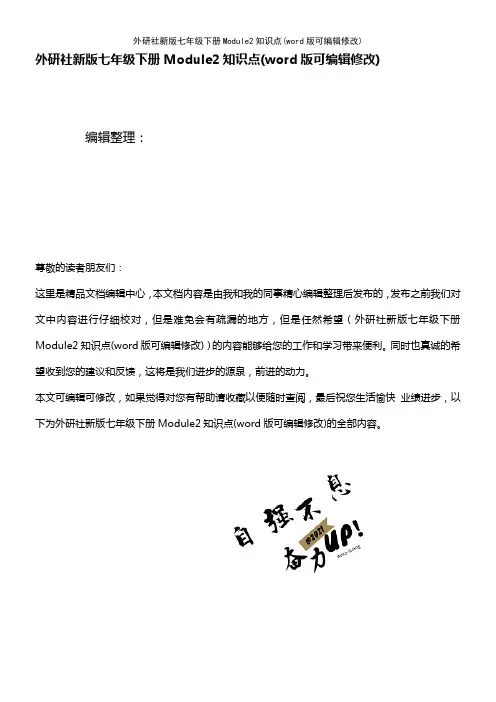
外研社新版七年级下册Module2知识点(word版可编辑修改)编辑整理:尊敬的读者朋友们:这里是精品文档编辑中心,本文档内容是由我和我的同事精心编辑整理后发布的,发布之前我们对文中内容进行仔细校对,但是难免会有疏漏的地方,但是任然希望(外研社新版七年级下册Module2知识点(word版可编辑修改))的内容能够给您的工作和学习带来便利。
同时也真诚的希望收到您的建议和反馈,这将是我们进步的源泉,前进的动力。
本文可编辑可修改,如果觉得对您有帮助请收藏以便随时查阅,最后祝您生活愉快业绩进步,以下为外研社新版七年级下册Module2知识点(word版可编辑修改)的全部内容。
一、重点单词speak▲ say一般作及物动词用,着重说话的内容,它的宾语可以是名词,代词或宾语从句。
Please say it in English。
请用英语用。
▲ speak强调说的动作,不强调所说的内容。
作及物动词时,常以某种语言作宾语。
作不及物动词时,常见的搭配形式有:speak of something/somebody谈到某事(某人)speak to sb 跟某人讲话,此外speak还可用于在较为正式的场合了表演讲或演说。
Can you speak Japanese?你会说日语吗?She is speaking to her teacher。
她正在跟她的老师说话。
▲ talk 一般为不及物动词,意思是“交谈,谈话,着重强调两具之间的相互说话。
eg: She is talking with Lucy in English。
What are you talking about?你们在谈论什么?The teacher is talking to him. 老师正在和他谈话。
▲ tell常作及物动词,意为“讲述,告诉,动词常跟双宾语。
tell sb sth=tell sth to sb 告诉某人某事。
eg: He is telling the children a story。
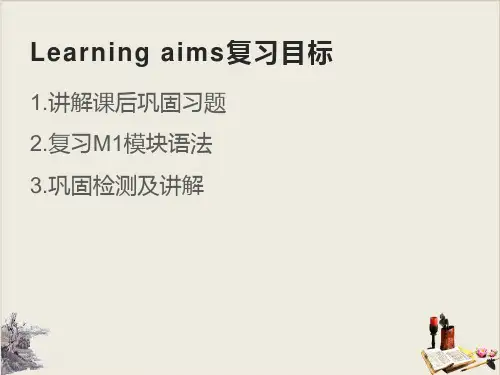
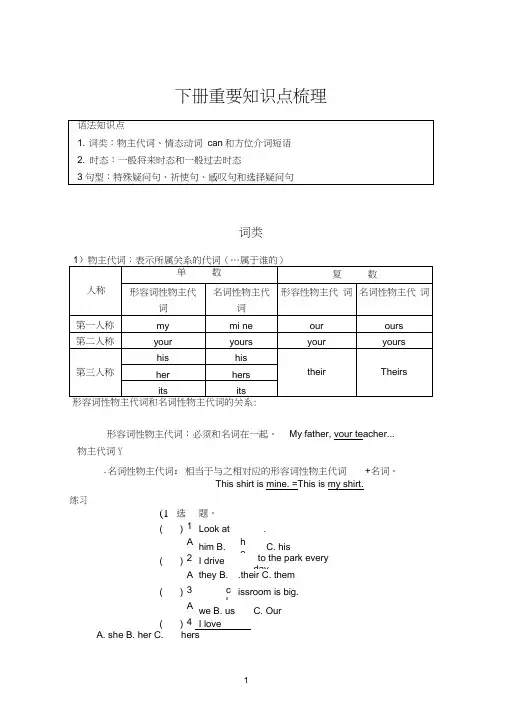
下册重要知识点梳理词类形容词性物主代词和名词性物主代词的关系:形容词性物主代词:必须和名词在一起。
My father, vour teacher... 物主代词Y-名词性物主代词:相当于与之相对应的形容词性物主代词+名词。
This shirt is mine. =This is my shirt.练习(1 )选择题。
( ) 1. Look at .A . him B.heC. his( ) 2. I drive to the park everydayA . they B. .their C. them( ) 3. clissroom is big.A . we B. us C. Our( ) 4. I loveA. sheB. herC. hers( )5. Do you know ?A. IB. myC. me( )6. I am son.A. theyB. theirC. them( )7. This is not desk.. My desk is over there.A. IB. myC. me( ) 8. —Can you spell n ame, Harry? —Sorry.A. youB.your <C. yours( )9. Tom and Jack are brothers. This is room.A. theyB. themC. their( )10. We are in the same class. classroom is very niceA. ourB. myC. ours( ) 11. Mrs. Green is my teacher. I ' m stude nt.A. heB. hisC. him( ) 12. That ' s a cat. n ame is Mimi.A. ItB. It 'sC. Its(2 ) 用括号里的代词的适当形式填空1, Mr Yang is ______ (we) teacher. _______ (him) is from Beiji ng. ______ (his) teaches _____ (our) En glish.2, Look,there is a cat. ______ (they) is Lily's. __ (it) n ame is Mimi.3, Let ____ (I) tell _____ (she) about _____ (he) life at school.4, This is _____ (they) room.Where is _____ (our)?5, Don't use the eraser. ____ is ______ (me).6, The lady un der the tree is _____ (me) aunt. ____ (her) ofte n sings with____ (she) husba nd2) 情态动词can1. 含义:表达人或物的能力,能或会…2. 特点:情态动词can没有人称和数的变化,之后要加动词原形。
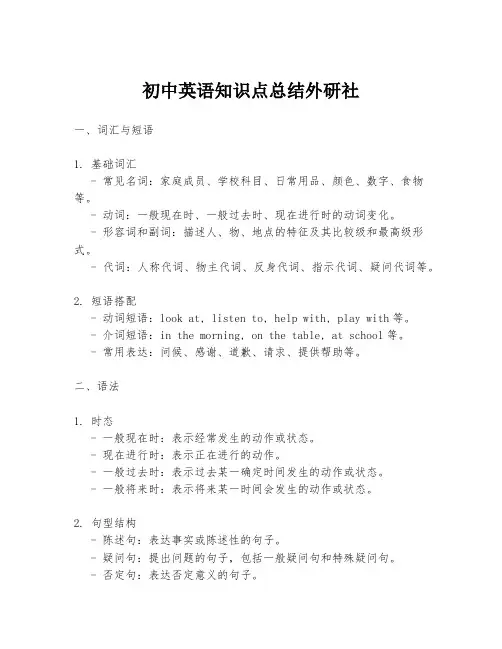
初中英语知识点总结外研社一、词汇与短语1. 基础词汇- 常见名词:家庭成员、学校科目、日常用品、颜色、数字、食物等。
- 动词:一般现在时、一般过去时、现在进行时的动词变化。
- 形容词和副词:描述人、物、地点的特征及其比较级和最高级形式。
- 代词:人称代词、物主代词、反身代词、指示代词、疑问代词等。
2. 短语搭配- 动词短语:look at, listen to, help with, play with等。
- 介词短语:in the morning, on the table, at school等。
- 常用表达:问候、感谢、道歉、请求、提供帮助等。
二、语法1. 时态- 一般现在时:表示经常发生的动作或状态。
- 现在进行时:表示正在进行的动作。
- 一般过去时:表示过去某一确定时间发生的动作或状态。
- 一般将来时:表示将来某一时间会发生的动作或状态。
2. 句型结构- 陈述句:表达事实或陈述性的句子。
- 疑问句:提出问题的句子,包括一般疑问句和特殊疑问句。
- 否定句:表达否定意义的句子。
- 祈使句:表示命令、请求或建议的句子。
3. 语态- 被动语态:表示句子的主语是动作的承受者。
4. 非谓语动词- 动名词:作为名词使用,可以作主语、宾语等。
- 分词:现在分词和过去分词,用作形容词或副词。
5. 从句- 宾语从句:作为句子宾语的从句。
- 定语从句:修饰名词或代词的从句,通常由关系代词引导。
- 状语从句:表示时间、原因、条件、结果等的从句。
三、阅读理解1. 阅读技巧- 快速阅读:通过略读抓住文章大意。
- 精读:仔细阅读,理解文章细节和深层含义。
- 寻找主题句:通常位于段落的开头,概括段落主要内容。
2. 阅读题型- 事实细节题:根据文章内容选择或判断正确的信息。
- 主旨大意题:确定文章或段落的中心思想。
- 推理判断题:根据文章内容进行逻辑推理,得出结论。
四、写作技巧1. 文章结构- 引言:介绍背景信息,引出文章主题。
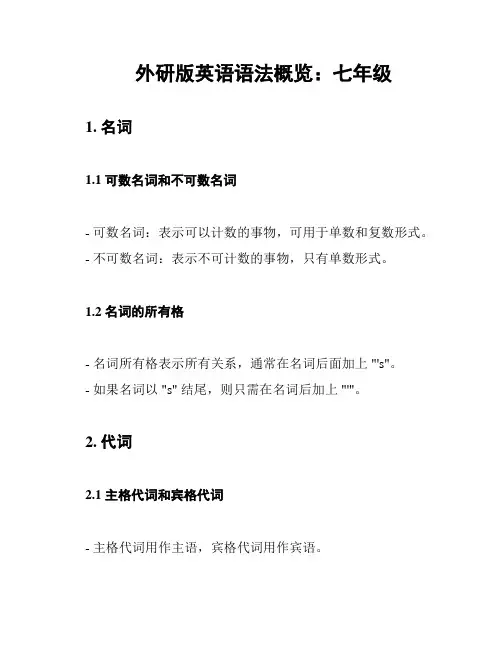
外研版英语语法概览:七年级1. 名词1.1 可数名词和不可数名词- 可数名词:表示可以计数的事物,可用于单数和复数形式。
- 不可数名词:表示不可计数的事物,只有单数形式。
1.2 名词的所有格- 名词所有格表示所有关系,通常在名词后面加上 "'s"。
- 如果名词以 "s" 结尾,则只需在名词后加上 "'"。
2. 代词2.1 主格代词和宾格代词- 主格代词用作主语,宾格代词用作宾语。
2.2 物主代词- 物主代词用于表示所属关系,如 "my"、"your"、"his"、"her" 等。
3. 冠词3.1 定冠词和不定冠词- 定冠词 "the" 用于特指某个人或物。
- 不定冠词 "a" 或 "an" 用于泛指或表示一个。
4. 动词4.1 现在时态- 一般现在时表示经常发生的动作或状态。
- 现在进行时表示正在进行的动作。
4.2 过去时态- 一般过去时表示过去发生的动作或状态。
5. 形容词5.1 形容词的比较级和最高级- 比较级用于比较两个人或物的程度。
- 最高级用于比较三个或三个以上人或物的程度。
6. 副词6.1 副词的用法- 副词用于修饰动词、形容词或其他副词。
7. 介词7.1 常见介词的用法- 介词用于表示时间、地点、方式等关系。
8. 连词8.1 并列连词和从属连词- 并列连词用于连接并列的词或句子。
- 从属连词用于引导从句。
9. 数词9.1 基数词和序数词- 基数词表示数量。
- 序数词表示顺序。
10. 句子成分10.1 主语和谓语- 主语是句子的主要话题。
- 谓语表示主语的动作或状态。
10.2 宾语和表语- 宾语接受动作的对象。
- 表语用于说明主语的属性或状态。
以上是外研版英语语法概览的七年级部分,包括名词、代词、冠词、动词、形容词、副词、介词、连词、数词和句子成分的相关知识点。
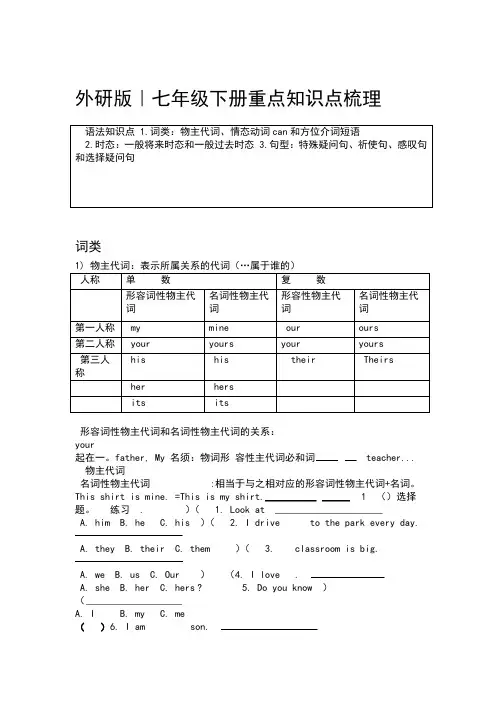
外研版|七年级下册重点知识点梳理词类形容词性物主代词和名词性物主代词的关系:your起在一。
father, My 名须:物词形容性主代词必和词teacher...物主代词名词性物主代词 :相当于与之相对应的形容词性物主代词+名词。
This shirt is mine. =This is my shirt. 1 ()选择题。
练习 . )( 1. Look atA. himB. heC. his)( 2. I drive to the park every day.A. theyB. theirC. them)( 3. classroom is big.A. weB. usC. Our)(4. I love .A. sheB. herC. hers? 5. Do you know )(A. IB. myC. me()6. I am son.A. theyB. theirC. them()7. This is not _____ desk.. My desk is over there.A. IB. myC. me()8. -Can you spell _____ name, Harry? -Sorry.A. youB. yourC. yours()9. Tom and Jack are brothers. This is _____ room.A. theyB. themC. their()10. We are in the same class. _____ classroom is very nice.A. ourB. myC. ours()11. Mrs. Green is my teacher. I'm _____ student.A. heB. hisC. him()12. That's a cat. _____ name is Mimi.A. ItB. It'sC. Its(2)用括号里的代词的适当形式填空1, Mr Yang is _______(we) (him) is from Beijing. _______(his)teaches______(our) English.2, Look,there is a (they) is Lily'(it) name is Mimi.3, Let______(I) tell ______(she) about_____(he) life at school.4, This is ______(they) is _____(our)?5, Don't use the is ______(me).6, The lady under the tree is ______(me) (her) often sings with _____(she) husband2)情态动词can1.含义:表达人或物的能力,能或会…2.特点:情态动词can没有人称和数的变化,之后要加动词原形。
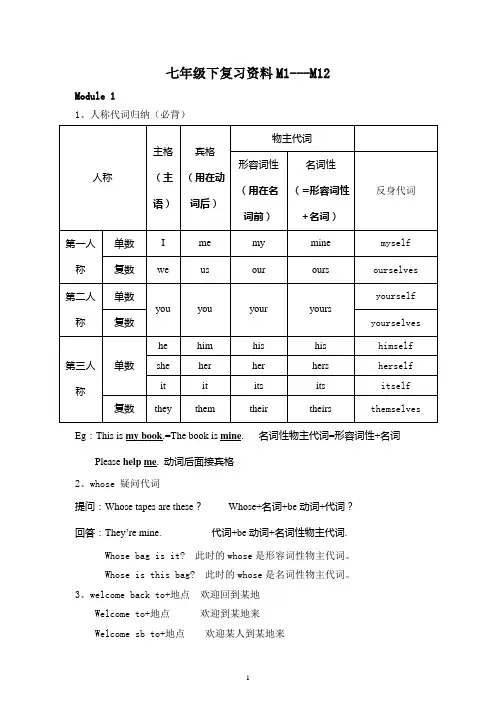
七年级下复习资料M1---M12Module 11、人称代词归纳(必背)Eg:This is my book.=The book is mine. 名词性物主代词=形容词性+名词Please help me. 动词后面接宾格2、whose 疑问代词提问:Whose tapes are these?Whose+名词+be动词+代词?回答:They’re mine. 代词+be动词+名词性物主代词.Whose bag is it? 此时的whose是形容词性物主代词。
Whose is this bag? 此时的whose是名词性物主代词。
3、welcome back to+地点欢迎回到某地Welcome to+地点欢迎到某地来Welcome sb to+地点欢迎某人到某地来4、everyone 每个人(指人)后面不能接ofevery one 每个人或物(根据上下文,可指人也可指物)后面可以接of Eg:every one of us我们中每个人5、first of all=at first = firstly 首先6、lost and found box 失物招领箱7、here’s、here’re句型,其后be动词的形式由后面的名词决定Eg:Here is a book. Here are some books.8、be careful with sth. 仔细保管某物9、from now on从现在开始 from then on 从那时开始10、watch 手表(名词);观看(动词)Watch 观看(电视,电影,比赛等) Look 看(表示动作,后接at) See 看见(强调结果) Read 看(看书、报纸,杂志等)11、lost and found office 失物招领办公室(前面用介词at)12、look for寻找(强调动作) find找到(强调结果)13、get on上(公交车,飞机,轮船,火车等)get off下(公交车,飞机,轮船,火车等)Get in上(小轿车) get out of 下(小轿车)14、lose 动词,丢失,失败 lost(lose的过去式,同时lost也作为形容词,意为丢失的)Eg:I lost my way。
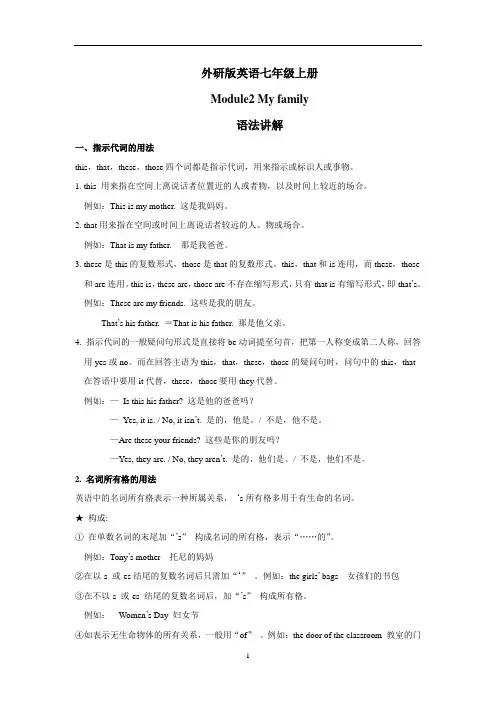
外研版英语七年级上册Module2 My family语法讲解一、指示代词的用法this,that,these,those四个词都是指示代词,用来指示或标识人或事物。
1. this 用来指在空间上离说话者位置近的人或者物,以及时间上较近的场合。
例如:This is my mother. 这是我妈妈。
2. that用来指在空间或时间上离说话者较远的人、物或场合。
例如:That is my father. 那是我爸爸。
3. these是this的复数形式,those是that的复数形式。
this,that和is连用,而these,those 和are连用。
this is,these are,those are不存在缩写形式,只有that is有缩写形式,即that’s。
例如:These are my friends. 这些是我的朋友。
That’s his father. =That is his father. 那是他父亲。
4. 指示代词的一般疑问句形式是直接将be动词提至句首,把第一人称变成第二人称,回答用yes或no。
而在回答主语为this,that,these,those的疑问句时,问句中的this,that在答语中要用it代替,these,those要用they代替。
例如:—Is this his father? 这是他的爸爸吗?—Yes, it is. / No, it isn’t. 是的,他是。
/ 不是,他不是。
—Are these your friends? 这些是你的朋友吗?—Yes, they are. / No, they aren’t. 是的,他们是。
/ 不是,他们不是。
2. 名词所有格的用法英语中的名词所有格表示一种所属关系,‘s所有格多用于有生命的名词。
★构成:①在单数名词的末尾加“’s”构成名词的所有格,表示“……的”。
例如:Tony’s mother 托尼的妈妈②在以-s 或-es结尾的复数名词后只需加“‘”。
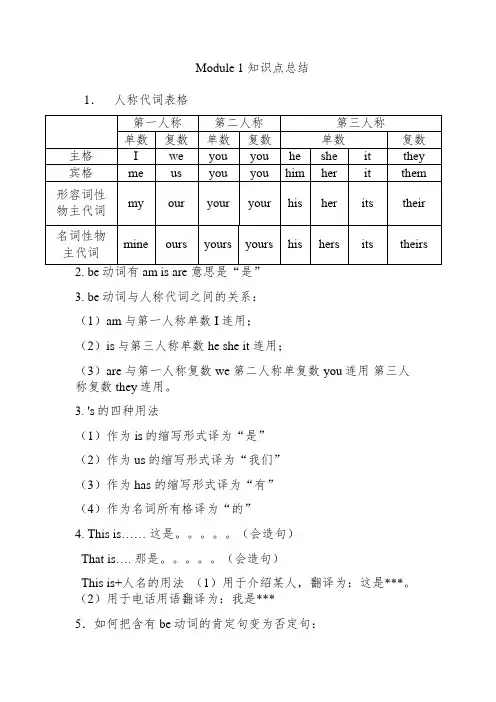
Module 1 知识点总结1.人称代词表格3. be动词与人称代词之间的关系:(1)am与第一人称单数I连用;(2)is与第三人称单数 he she it 连用;(3)are 与第一人称复数we 第二人称单复数you连用第三人称复数they连用。
3. 's的四种用法(1)作为is的缩写形式译为“是”(2)作为us的缩写形式译为“我们”(3)作为has 的缩写形式译为“有”(4)作为名词所有格译为“的”4. This is……这是。
(会造句)That is…. 那是。
(会造句)This is+人名的用法(1)用于介绍某人,翻译为:这是***。
(2)用于电话用语翻译为:我是***5.如何把含有be动词的肯定句变为否定句:直接在be动词后面加not6. 用yes和no来回答的疑问句叫做一般疑问句7. 如何把含有be动词的肯定句改为一般疑问句:(1)把be动词提到句首;(2)句中有第一人称要改为相对应的第二人称;(3)be动词要随着主语人称与数的变化而变化。
8.Is this ……?引导一般疑问句的答语:(1)先观察主语是人还是物(2)如果主语是人,肯定答语为:Yes,she/he is .否定答语为:No,she/he isn’t.(3)如果主语是物,肯定答语为:yes, it is. 否定答语为:No, it isn’t.9. 以特殊疑问词开头的疑问句叫做特殊疑问句。
10.如何对划线部分进行提问(1)先把所给句改为一般疑问句(2)根据划线部分找相对应的特殊疑问词(3)把特殊疑问词放句首,后加一般疑问句。
11.重点句型(1)用于自我介绍:My name is +名字。
= I am +名字。
拓展:His name is +名字。
=He is + 名字。
Her name is +名字。
=He is +名字。
(2)用于询问对方的名字:What’s your name?拓展:What’s his name?What’s her name?(4)Can you spell it? 你能拼出来吗?(5)How are you ? 答语是I’m fine.=I’m ok.=I’m very well.=I’m not bad.=I’m very well.拓展:How is he?/How is she?/How is Lingling’s mother? 以及根据上面的答语学会回答(6)It’s time to go now. 是该走的时候了。
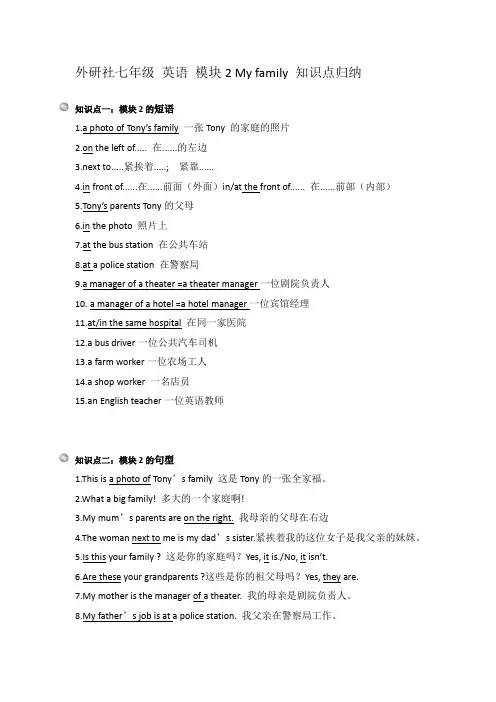
外研社七年级英语模块2 My family 知识点归纳知识点一:模块2的短语1.a photo of Tony’s family一张Tony 的家庭的照片2.on the left of..... 在......的左边3.next to.....紧挨着.....; 紧靠......4.in front of......在......前面(外面)in/at the front of...... 在......前部(内部)5.Tony’s parents Tony的父母6.in the photo 照片上7.at the bus station 在公共车站8.at a police station 在警察局9.a manager of a theater =a theater manager一位剧院负责人10. a manager of a hotel =a hotel manager一位宾馆经理11.at/in the same hospital 在同一家医院12.a bus driver一位公共汽车司机13.a farm worker一位农场工人14.a shop worker 一名店员15.an English teacher一位英语教师知识点二:模块2的句型1.This is a photo of Tony’s family 这是Tony的一张全家福。
2.What a big family! 多大的一个家庭啊!3.My mum’s parents are on the right. 我母亲的父母在右边4.The woman next to me is my dad’s sister.紧挨着我的这位女子是我父亲的妹妹。
5.Is this your family ? 这是你的家庭吗?Yes, it is./No, it isn’t.6.Are these your grandparents ?这些是你的祖父母吗?Yes, they are.7.My mother is the manager of a theater. 我的母亲是剧院负责人。
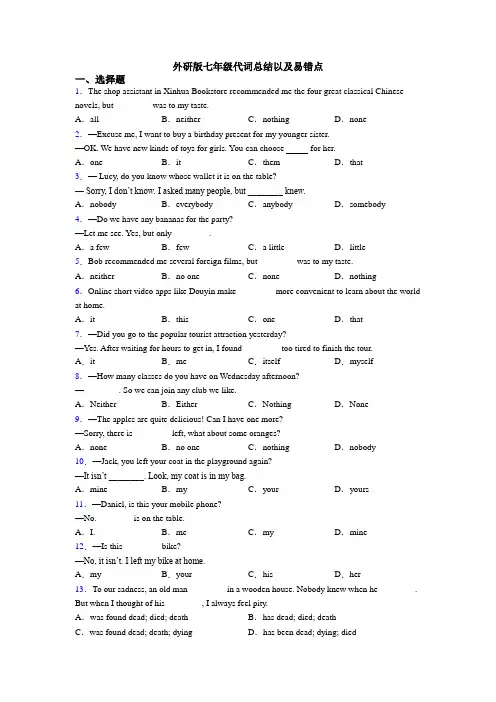
外研版七年级代词总结以及易错点一、选择题1.The shop assistant in Xinhua Bookstore recommended me the four great classical Chinese novels, but ________ was to my taste.A.all B.neither C.nothing D.none 2.—Excuse me, I want to buy a birthday present for my younger sister.—OK. We have new kinds of toys for girls. You can choose for her.A.one B.it C.them D.that3.— Lucy, do you know whose wallet it is on the table?—Sorry, I don’t know. I asked many people, but ________ knew.A.nobody B.everybody C.anybody D.somebody 4.—Do we have any bananas for the party?—Let me see. Yes, but only ________.A.a few B.few C.a little D.little5.Bob recommended me several foreign films, but ________ was to my taste.A.neither B.no one C.none D.nothing 6.Online short video apps like Douyin make ________ more convenient to learn about the world at home.A.it B.this C.one D.that7.—Did you go to the popular tourist attraction yesterday?—Yes. After waiting for hours to get in, I found ________ too tired to finish the tour.A.it B.me C.itself D.myself8.—How many classes do you have on Wednesday afternoon?—________. So we can join any club we like.A.Neither B.Either C.Nothing D.None9.—The apples are quite delicious! Can I have one more?—Sorry, there is ________ left, what about some oranges?A.none B.no one C.nothing D.nobody 10.—Jack, you left your coat in the playground again?—It isn’t ________. Look, my coat is in my bag.A.mine B.my C.your D.yours 11.—Daniel, is this your mobile phone?—No. ________is on the table.A.I. B.me C.my D.mine12.—Is this ________ bike?—No, it isn’t. I left my bike at home.A.my B.your C.his D.her13.To our sadness, an old man ________ in a wooden house. Nobody knew when he ________. But when I thought of his ________, I always feel pity.A.was found dead; died; death B.has dead; died; deathC.was found dead; death; dying D.has been dead; dying; died14.Teachers use ________ knowledge to help children become intelligent teenagers.A.they B.them C.their D.theirs 15.—Dave, did you have fun at the New Year's Party?—Sure! I will never forget each wonderful memory of ________.A.we B.us C.our D.ours16.It’s known to all that the Chinese are famous for ________ hard work and wisdom. A.they B.them C.their D.themselves 17.Wearing red makes________easy________us to take action.A.it; for B.this; of C.that; for D.it; of 18.—Could you tell me how many classes you have on Friday afternoon?—___________. We can take part in activities in any club we like.A.None B.Nothing C.Neither D.Either 19.Though I agree with most of what you said, that doesn't mean I agree with _________. A.anything B.nothing C.everything D.something 20.—Why did your family buy a second-hand car?—We couldn’t afford a new one, but even an old one is better than ________.A.none B.either C.nothing D.neither21.— When would you like to go to Nanjing Garden Expo (园博园) with me, this Friday or Saturday?— ________. I am free only this Sunday.A.Both B.None C.Neither D.Either22.The girl got a new bike from her father and she loves ________ colour very much.A.it B.itself C.its D.it’s 23.—Jeffrey always remained calm and mastered his own feelings.—No wonder he is a ________.A.somebody B.anybody C.nobody D.everyone 24.They have provided several ways to solve the problem. We can choose _________ to start with.A.it B.that C.one D.each25.Wu Xinhai, a stay-at-home dad, said “I want my kids to have a different childhood from________.”A.me B.mine C.myself D.I26.—Are your parents angry with you about your English?—Oh, ________ of them is angry. They just told me to get better grades next time.A.none B.both C.neither D.either27.— Who was calling you on the phone just now?— ________ was my mum.A.She B.That C.It D.This28.—All of us will visit Beijing Daxing International Airport next week.—Great! ________ of us has been there before and we want to know more about the local culture.A.None B.Either C.Both D.All29.I want to buy a fine tie for my father, but ________ is fit for him in the shops nearby.A.no one B.nothing C.none D.neither30.The chairman thought ________ necessary to invite Professor Johnson to speak at the meeting.A.that B.it C.this D.him31.Think twice and make the decision. _______ else can do it for you.A.Somebody B.Nobody C.Everybody D.Anybody 32.Dora always comes up with new ideas, but ________ is of any value to me.A.none B.nothing C.no one D.neither33.The teacher shared the photos of our school trip on her WeChat Moments. We can see them for ________.A.herself B.himself C.ourselves D.themselves34.As the old saying goes, politeness costs nothing and gains ________.A.nothing B.anything C.everything D.something 35.—Excuse me, is there a supermarket nearby?—I know ________. I will take you there.A.it B.one C.some D.that36.— Have you got any books on the differences between Chinese and Western festivals? I want to borrow one.— Yes, here you are. But you must return _______by Sunday.A.one B.it C.this D.that37.—He was the strong silent type.—Yes. He thought ________ better to say nothing.A.it B.its C.it’s D.itself38.We found ________ easy to finish the task by working as a team.A.it’s B.that C.this D.it39.Wu Xinhai, a stay-at-home dad in Beijing, said: “I want my kids to have a different childhood from ________.”A.my B.me C.myself D.mine40.The new workshop can not only help students learn different skills but also teach _________ to care about others.A.they B.them C.their D.themselves【参考答案】一、选择题1.D解析:D【详解】句意:新华书店的店员向我推荐了四大中国古典小说,但没有一本合我的口味。
七年级英语m2外研版知识点外研版英语教材一直以来都备受广大教育工作者和家长们的青睐和推崇,而在七年级英语M2外研版教材中,包含的知识点也是相当丰富和有用的。
下面就为大家一一介绍。
一、语法知识点1. 一般现在时一般现在时是英语语法中非常基础的一个时态,表示经常或习惯性的动作以及客观事实等,其基本结构为主语+谓语动词原形。
例如:I usually get up at 6:30 every morning.2. 现在进行时现在进行时用于表示正在进行中的动作,其基本结构为主语+ be动词+现在分词。
例如:I am playing soccer with my friends now.3. 一般过去时一般过去时用于表示过去某个时间里发生的动作,其基本结构为主语+过去式。
例如:She went to the park yesterday.4. be动词的变化be动词是英语语法中的一种最基础的动词,也是最常用的动词之一。
它的基本结构为主语+ be动词。
例如:I am a student.二、词汇知识点1. 数字数字在日常英语交流中也是非常常见的,对于七年级的学生来说,了解英文数字的读法和写法也是非常重要的。
例如:3(three)、78(seventy-eight)、145(one hundred and forty-five)。
2. 祈使句祈使句是用于表达请求、命令等意义的语句,其基本结构为动词原形+其他成分。
例如:Open the door, please.3. 职业在七年级英语M2外研版教材中,学生将接触到不少关于职业的词汇,这对于今后的人生规划也是非常重要的一个知识点。
例如:doctor、teacher、singer。
4. 颜色颜色也是英语交流中非常重要和基础的一个知识点,学生应该掌握英语的基本颜色词汇。
例如:red(红色)、blue(蓝色)、green(绿色)。
三、阅读知识点1. 选择题选择题是英语中比较常见的题型,通常要求学生从几个选项中选出正确的答案。
一、要点单词speak▲ say 一般作及物动词用,侧重说话的内容,它的宾语能够是名词,代词或宾语从句。
Please say it in English.请用英语用。
▲ speak 重申说的动作,不重申所说的内容。
作及物动词时,常以某种语言作宾语。
作不及物动词时,常有的搭配形式有:speak of something/somebody谈到某事(某人) speak to sb跟某人发言,别的 speak还可用于在较为正式的场合了表演讲或演说。
Can you speak Japanese?你会说日语吗?She is speaking to her teacher.她正在跟她的老师说话。
▲ talk 一般为不及物动词,意思是“谈话,发言,侧重重申两具之间的互相说话。
eg: She is talking with Lucy in English.What are you talking about?你们在讨论什么?The teacher is talking to him.老师正在和他发言。
▲ tell 常作及物动词,意为“叙述,告诉,动词常跟双宾语。
tell sb sth = tell sth to sb告诉某人某事。
eg: He is telling the children a story.Did you tell her the news?= Did you tell the news to her?join 参加(1) 指加入某个党派,集体组织等,成为其成员之一,意为:“从军、入团、入党 ”等。
如:When did your brother join the army?你哥哥什么时候从军的?(2) 和某人一道做某事,其构造为:join sb. in (doing) sth.,依据上下文, in (doing) sth.也能够省去。
如:Will you join us in the discussion?你参加我们的议论吗?We're going to the East Lake Park on Sunday. Will you join us?【辨析】take part in指参加会议或民众性活动等,侧重说明句子主语参加该项活动并在活动中发挥作用。
外研版七年级英语代词用法一、选择题1.You are supposed to bring _________ to his attention that the journey will be really tiring. A.that B.it C.this D.you 2.—Sam, there are so many spelling mistakes in your paper. You should try not torepeat________.—Sorry, Mr. White. I'll be more careful from now on.A.it B.its C.them D.theirs 3.—Mum, our dolls’ clothes are so dirty.—You may wash them, but be careful to keep ________ clean.A.them B.your C.yours D.theirs4.—Do we have any bananas for the party?—Let me see. Yes, but only ________.A.a few B.few C.a little D.little5.—Oh, I came in such a hurry that I left my text book at home.—Don’t worry. I’ll share ________ with you.A.my B.me C.myself D.mine 6.Seasons in Australia are the opposite of ________. It’s autumn there.A.us B.we C.our D.ours7.—How many classes do you have on Wednesday afternoon?—________. So we can join any club we like.A.Neither B.Either C.Nothing D.None8.—Why did your family buy a second-hand car?—We couldn’t afford a new one, but even an old one is better than ________.A.none B.either C.nothing D.neither 9.—Today’s Yangtze Evening, please.—There’s only one copy left. Would you like ________?A.they B.them C.it D.one10.The shop assistant in Xinhua Bookstore recommended me the four great classical Chinese novels, but ________ was to my taste.A.all B.neither C.nothing D.none11.—This book on animals is interesting. I’d like ________. Where did you buy it, Simon?—In the bookshop near my school.A.it B.this C.that D.one12.—Is this ________ bike?—N o, it isn’t. I left my bike at home.A.my B.your C.his D.her13.We couldn’t understand ________ because they were talking in Russian.A.they B.them C.their D.theirs14.To our sadness, an old man ________ in a wooden house. Nobody knew when he ________. But when I thought of his ________, I always feel pity.A.was found dead; died; death B.has dead; died; deathC.was found dead; death; dying D.has been dead; dying; died 15.Teachers use ________ knowledge to help children become intelligent teenagers.A.they B.them C.their D.theirs16.I can take good care of myself. I do not depend on ________.A.anybody B.everybody C.nothing D.something 17.The young should learn how to look after ________ and be more independent.A.they B.them C.their D.themselves 18.It’s kno wn to all that the Chinese are famous for ________ hard work and wisdom. A.they B.them C.their D.themselves 19.It’s very convenient ______ us to buy train tickets now because we can buy them either from the station or on the Internet.A.to B.of C.by D.for20.Wait a minute. I have ________ more to tell you about the travelling plan.A.something B.everything C.anything D.nothing 21.—Excuse me, is there a supermarket nearby?—I know ________. I will take you there.A.it B.one C.some D.that22.Some friends tried to calm down Mr. and Mrs. White and help solve their problem without hurting the feeling of ________, but failed.A.none B.either C.both D.neither23.He thinks himself ________, but we think him ________.A.somebody, anybody B.somebody, nobody C.anybody, somebody D.anybody, nobody 24.They have provided several ways to solve the problem. We can choose _________ to start with.A.it B.that C.one D.each25.Wu Xinhai, a stay-at-home dad, said “I want my kids to have a different childhood from________.”A.me B.mine C.myself D.I26.The chairman thought ________ necessary to invite Professor Johnson to speak at the meeting.A.that B.it C.this D.him27.The sheep are eating grass on the hill. How happy ________ look!A.it B.its C.they D.them 28.—Though the film Hi, mom has achieved a great success, it isn’t liked by ________.—I think so. It is hard to please all.A.nobody B.somebody C.everybody D.anybody29.Life is like a one-way street. ________ will happen________ the same way again. A.Nothing; by B.Nothing;/ C.None; in D.None;on 30.—Excuse me, I want to buy a birthday gift for my brother.—Here are some gifts for boys. You can choose ________ for him.A.it B.one C.that D.them31.Think twice and make the decision. _______ else can do it for you.A.Somebody B.Nobody C.Everybody D.Anybody32.If something is wrong, fix it. Do not worry. Worry never fixes ________.A.something B.anything C.nothing D.everything 33.—He was the strong silent type.—Yes. He thought ________ better to say nothing.A.it B.its C.it’s D.itself34.—Few films have had a greater effect on popular culture than Steven Spielberg’s.—It’s just your cup of tea. To me, his works are ________ more than entertainment. A.something B.anything C.nothing D.everything 35.—Are there any air tickets to Hong Kong?—Sorry. There is ________ left.A.nothing B.none C.nobody D.no one 36.—Can you play football or basketball?—________of them. I’m good at ball games.A.Both B.All C.Neither D.None37.—The apples are quite delicious! Can I have one more?—Sorry, there is ________ left, what about some oranges?A.none B.no one C.nothing D.nobody 38.—Do you know whose books they are on the desk?—I don't know. They' re not ________. Ask Andrew, please.A.mine B.me C.my D.I39.Jeff dreams of becoming a detective like Sherlock Homes. He thinks there is ________ more exciting than solving a mystery.A.everything B.something C.anything D.nothing 40.Some friends tried to calm down Mr. and Mrs. White and help solve their problem without hurting the feeling of ________, but failed.A.both B.none C.either D.neither【参考答案】一、选择题1.B解析:B【详解】句意:你应该让他注意到这次旅行会很累。
七年级外研版中英语代词的用法归纳总结及解析一、选择题1.We’d like to recommend Millie as the Young Star because of ________ effort and kindness. A.our B.ours C.her D.hers 2.—Sam, there are so many spelling mistakes in your paper. You should try not torepeat________.—Sorry, Mr. White. I'll be more careful from now on.A.it B.its C.them D.theirs 3.—This book on animals is interesting. I’d like ________. Where did you buy it, Simon?—In the bookshop near my school.A.it B.this C.that D.one 4.—Today’s Yangtze Evening, please.—There’s only one copy left. Would you like ________?A.they B.them C.it D.one 5.—Mum, our dolls’ clothes are so dirty.—You may wash them, but be careful to keep ________ clean.A.them B.your C.yours D.theirs6.—Do you know the percentage of the people who want to leave the Earth in China?—I think there is ________. In fact, there is ________ on other planets that can help people survive.A.nothing; none B.none; nothing C.nobody; none D.none; no one 7.— Lucy, do you know whose wallet it is on the table?— Sorry, I don’t know. I asked many people, but ________ knew.A.nobody B.everybody C.anybody D.somebody 8.—Do we have any bananas for the party?—Let me see. Yes, but only ________.A.a few B.few C.a little D.little9.Bob recommended me several foreign films, but ________ was to my taste.A.neither B.no one C.none D.nothing 10.Online short video apps like Douyin make ________ more convenient to learn about the world at home.A.it B.this C.one D.that 11.—Did you go to the popular tourist attraction yesterday?—Yes. After waiting for hours to get in, I found ________ too tired to finish the tour.A.it B.me C.itself D.myself 12.—Where would you like to have a picnic, near Yangcheng Lake or in Forest Park?— ________ . You decide. I just want to relax myself in the beautiful nature.A.Either B.Neither C.Both D.None 13.Robots are created by humans for humans. There’s ________ to be afraid of. A.something B.nothing C.everything D.anything 14.—Do you know whose books they are on the desk?—I don't know. They' re not ________. Ask Andrew, please.A.mine B.me C.my D.I15.—Is this ________ bike?—No, it isn’t. I left my bike at home.A.my B.your C.his D.her16.We couldn’t understand ________ because they were talking in Russian.A.they B.them C.their D.theirs17.They all think ________ to create such beautiful music with the transparent cups.A.it amazed B.that amazed C.it amazing D.that is amazing 18.—If you are buying today's Suzhou Daily, could you get ________ for me?—I'm glad to help you.A.it B.this C.one D.that19.My mother tried to cook ________ for me when I studied in New Zealand.A.different something B.different anything C.something different D.anything different 20.The young should learn how to look after ________ and be more independent.A.they B.them C.their D.themselves 21.—Dave, did you have fun at the New Year's Party?—Sure! I will never forget each wonderful memory of ________.A.we B.us C.our D.ours22.—Are these cars made in Japan?—Yes, and they’re much cheaper than ___________ in American.A.that B.those C.it D.ones23.It’s very convenient ______ us to buy train tickets now because we can buy them either from the station or on the Internet.A.to B.of C.by D.for24.Though I agree with most of what you said, that doesn't mean I agree with _________. A.anything B.nothing C.everything D.something 25.Seasons in Australia are the opposite of ________. It’s autumn there.A.us B.we C.our D.ours 26.—David, I have ________ to tell you.—Great! I’m excited to hear our country has made progress in exploring the space. A.something important B.anything important C.important something D.important anything27.He thinks himself ________, but we think him ________.A.somebody, anybody B.somebody, nobody C.anybody, somebody D.anybody, nobody 28.They have provided several ways to solve the problem. We can choose _________ to start with.A.it B.that C.one D.each29.As a child, I would sit for hours under an old tree doing ________, which was simply day dreaming.A.nothing B.everything C.something D.anything 30.—Mary, is this ________ blue bike?—No, ________ is a black one.A.your; my B.your; mine C.yours; my D.yours; mine 31.— There are more TV series than before.—That’s true. But ________ was to my taste. I prefer westerns.A.all B.few C.some D.none32.My parents have made ________ a habit to go out for a walk around Xuanwu Lake.A.this B.it C.that D.one33.— When would you like to go to Nanjing Garden Expo (园博园) with me, this Friday or Saturday?— ________. I am free only this Sunday.A.Both B.None C.Neither D.Either34.My elder brother is creative, he is always full of ideas, but ________ is useful to my knowledge.A.neither B.nothing C.no one D.none35.As the old saying goes, politeness costs nothing and gains ________.A.nothing B.anything C.everything D.something 36.Some friends tried to calm down Mr. and Mrs. White and help solve their problem without hurting the feeling of ________, but failed.A.both B.none C.either D.neither37.Jeff dreams of becoming a detective like Sherlock Homes. He thinks there is ________ more exciting than solving a mystery.A.everything B.something C.anything D.nothing38.The weather in Beijing is cooler than ________ in Guangzhou.A.this B.that C.it D.one39.Some friends tried to calm down Mr. and Mrs. White and help solve their problem without hurting the feeling of ________, but failed.A.none B.either C.both D.neither 40.—Excuse me, is there a supermarket nearby?—I know ________. I will take you there.A.it B.one C.some D.that41.If something is wrong, fix it. Do not worry. Worry never fixes ________.A.something B.anything C.nothing D.everything 42.— Have you got any books on the differences between Chinese and Western festivals? I want to borrow one.— Yes, here you are. But you must return _______by Sunday.A.one B.it C.this D.that43.—He was the strong silent type.—Yes. He thought ________ better to say nothing.A.it B.its C.it’s D.itself44.—Are there any air tickets to Hong Kong?—Sorry. There is ________ left.A.nothing B.none C.nobody D.no one 45.—Can you play football or basketball?—________of them. I’m good at ball games.A.Both B.All C.Neither D.None46.It is wrong to copy others’ answers. Do homework by ________, boys!A.yourself B.yourselves C.myself D.ourselves 47.—The apples are quite delicious! Can I have one more?—Sorry, there is ________ left, what about some oranges?A.none B.no one C.nothing D.nobody 48.—Have you prepared ________ for the picnic tomorrow?—-No, except the drinks.A.nothing B.anything C.everything D.something49.I want to buy a fine tie for my father, but ________ is fit for him in the shops nearby. A.no one B.nothing C.none D.neither 50.—Excuse me, I want to buy a birthday gift for my brother.—Here are some gifts for boys. You can choose ________ for him.A.it B.one C.that D.them二、选择题51.The man next door is a ________ to Bruce. He doesn’t even know the neighbor’s name. A.stranger B.volunteer C.trainer D.teacher 52.— Did Lucy dress herself beautifully at her birthday party?—Yeah, of course. Her white dress caught everyone’s ______.A.celebration B.organization C.introduction D.attention 53.Peter is interested in reading books about animals and plants. He has a real ________ of animals, birds and flowers.A.courage B.energy C.knowledge D.experience 54.— How do you like Jianye Library?—Wonderful! I’m espec ially satisfied with the high ________ of its service.A.cost B.value C.standard D.price 55.—What’s on the table?—Can’t you see? There are some ________ of milk.A.packets B.glasses C.bottles D.cartons 56.The ________ on the desk is for you. It says Mr. Lee is coming to visit you tomorrow. A.advice B.lesson C.paper D.message 57.Because plenty of _______ were found, Sanxingdui Ruins was named the Scientific Education Base for China’s Youth (中国青少年科教基地) in March this year.A.standards B.projects C.treasures D.instructions 58.People in many foreign countries have parties on Chinese New Year’s Eve now. It means agrowing ________ in Chinese culture around the world.A.direction B.habit C.dream D.interest 59.Because of the growing needs of market, the ________ of blind boxes will quickly rise. A.pollution B.production C.pronunciation D.population 60.—Though he never held a high ________ in the government, he still cared about common people.—That’s why many people respected him.A.condition B.position C.education D.situation 61.Look! The children are having so much ________ playing hide and seek in the flower sea. A.joke B.fun C.knowledge D.skill62.—Do you know the four new great ________of China?—Yes. They are Alipay, high-speed trains, shared bikes and online shopping.A.inventions B.introductions C.attractions D.traditions 63.Learning English in a classroom is important, but using English in the real ________ will improve your English skills greatly.A.condition B.situation C.event D.position 64.—Sam’s ________ is worth praising, but saving someone from the river alone is too dangerous.—Yes. As teenagers, we had better ask adults for help.A.humour B.courage C.wisdom D.purpose 65.—Do you think Mary has made a wrong ________?—No, I don’t think so. It’s good for her to live alone.A.experience B.experiment C.difference D.decision 66.—We have entered a world where robot operations become true with 5G technology.—Hard to believe! Scientists are full of ________ which leads to great changes in our life. A.instruction B.instrument C.invention D.introduction 67.As a student, getting up early and being afraid of missing the first school bell may be common ________ for you. But thanks to new rules, you can stay in bed longer than before. A.signs B.symbols C.experiences D.expressions 68.I'm sure Cindy will make it to the hotel. She has a good ________ of directions.A.idea B.feeling C.experience D.sense69.If you are interested in something, it's easier for you to pay ________ to it for a long time. A.attention B.interest C.progress D.information 70.For the time being we can collect much ________ either from books or on the Internet. A.idea B.method C.information D.suggestion 71.Wu Wei, a young artist, has received high_________ from the art community for this sculpturesA.pride B.praise C.promise D.progress 72.—I didn’t have the to go out alone at night when I was a little child.—So did I. But now I’m brave enough.A.courage B.power C.ability D.chance73.–Could you give me a few ______ on how to spend the coming summer holiday?--OK. Let me see.A.hobbies B.knowledge C.suggestions D.information 74.The ____of antibiotics(抗生素) in the 20th century has made a great difference to us. A.invention B.instruction C.method D.discovery 75.—Dad, what is the loudspeaker saying?—It is to the ________.The fight to Shanghai is checking tickets now.A.customers B.passengers C.members D.tourists 76.—Yuan Longping and his team have succeeded in planting saltwater rice.—I’ve heard about it. He has made a huge ________ to our country’s agr iculture.A.invention B.competition C.contribution D.production 77.— Do you really think you can learn that much in only a couple of hours?— Yes. We will try a very useful ________ of dealing with memory problems.A.report B.process C.method D.activity78.This is a ________ of our city. Look! Our school is here.A.map B.music C.name D.team79.One person’s ________ doesn’t depend on how much money he has made, but on how many contributions he has made to our country.A.experience B.value C.wealth D.career80.I was attracted by the lady’s warm smile. It was really like a hidden ________ . A.pleasure B.treasure C.attention D.invention81.My sister has no sense of ________. She always gets lost in the city streets.A.shame B.duty C.direction D.humour82.All the ________ was for nothing because the visit was cancelled. Put it away now. A.pollution B.connection C.suggestion D.preparation 83.— Do you stay up at night and get up late in the morning just like me?—Never. I think you’d better break that_________.A.habit B.project C.ability D.advice84.I think some famous stars should pay more attention to their behavior because what they do can have a great ________ on teenagers.A.change B.impression C.progress D.influence85.If you’re good at English, you will ha ve one more ________ when searching for jobs. A.method B.advantage C.interest D.interview 86.Recently, he seemed to be not himself and gave up many chances. We’d better do something to stop him losing the ________ of his life.A.sense B.course C.direction D.condition 87.—Finding information is not a big deal today.—Yes. The ________ is how to tell whether the information is true or not.A.advantage B.message C.challenge D.knowledge88.The filmmakers should pay more attention to improving the ________ of a film than making more money.A.quality B.position C.charity D.personality 89.—Searching for information is not a big deal today.—Exactly, the ________ is how we can tell whether the information is true or not. A.advantage B.message C.challenge D.knowledge 90.— I hear that you have bought a smart car. Does the car give you any good ________ for your money?— Certainly.A.value B.price C.wealth D.cost 91.—Have you heard of a new technology about TV?—Yes. It’s “8K TV”. I believe that it will make a great ________ to people’s life.A.surprise B.progress C.difference D.choice92.The police give us a lot of ________ on how to protect personal information.A.trust B.advice C.stress D.difficulty 93.With the ________ of the computer, museums today are different from what they used to be. A.invitation B.introduction C.communication D.pronunciation 94.— What is the ________ of your excellent works?— Just practice again and again.A.value B.duty C.secret D.result95.The number of the people using Huawei _______is getting larger and largerA.cultures B.customers C.histories D.products 96.After listening to the ________ to the Flower Sea, we become more interested in this place. A.influence B.instrument C.introduction D.instruction 97.My grandmother knows the history and medical ________ of many plants.A.wealth B.price C.value D.cost 98.—Wow, you play the violin so well!—Thank you, but that’s the only musical ________ I can play.A.instruction B.instrument C.introduction D.invention 99.—Why did the artist make no ________ to be understood or liked?—He didn’t care what others think of him.A.risk B.effort C.suggestion D.balance100.My computer caught a ________ the other day and all the information went missing. A.virus B.disease C.problem D.trouble【参考答案】***试卷处理标记,请不要删除一、选择题1.C解析:C【详解】句意:由于米莉的努力和善良,我们想推荐她为青年之星。
外研版小升初初中英语语法代词讲解一、选择题1.—Wow! Jim plays the piano so well.—Not ________ can play it like this. He works hard at it.A.everybody B.somebody C.nobody D.anybody 2.Wearing red makes________easy________us to take action.A.it; for B.this; of C.that; for D.it; of3.I want to buy a fine tie for my father, but ________ is fit for him in the shops nearby.A.no one B.nothing C.none D.neither4.—Do you know the percentage of the people who want to leave the Earth in China?—I think there is ________. In fact, there is ________ on other planets that can help people survive.A.nothing; none B.none; nothing C.nobody; none D.none; no one 5.— Lucy, do you know whose wallet it is on the table?—Sorry, I don’t know. I asked many people, but ________ knew.A.nobody B.everybody C.anybody D.somebody 6.—Do we have any bananas for the party?—Let me see. Yes, but only ________.A.a few B.few C.a little D.little7.Online short video apps like Douyin make ________ more convenient to learn about the world at home.A.it B.this C.one D.that8.—Oh, I came in such a hurry that I left my text book at home.—Don’t worry. I’ll share ________ with you.A.my B.me C.myself D.mine 9.—Daniel, is this your mobile phone?—No. ________is on the table.A.I. B.me C.my D.mine10.—Why did your family buy a second-hand car?—We couldn’t afford a new one, but even an old one is better than ________.A.none B.either C.nothing D.neither 11.—Excuse me, is there a supermarket nearby?—I know ________. I will take you there.A.it B.one C.some D.that12.The shop assistant in Xinhua Bookstore recommended me the four great classical Chinese novels, but ________ was to my taste.A.all B.neither C.nothing D.none13.We couldn’t understand ________ because they were talking in Russian.A.they B.them C.their D.theirs14.They all think ________ to create such beautiful music with the transparent cups.A.it amazed B.that amazed C.it amazing D.that is amazing15.—Which of the two dresses will you choose for the party?—________ of them is suitable for a birthday party. They are too formal.A.Neither B.None C.Either D.Both 16.Teachers use ________ knowledge to help children become intelligent teenagers.A.they B.them C.their D.theirs 17.—Dave, did you have fun at the New Year's Party?—Sure! I will never forget each wonderful memory of ________.A.we B.us C.our D.ours18.Miss Liu is kind enough to help us whenever she is needed. We all like ______.A.she B.her C.him D.them19.It’s very convenient ______ us to buy train tickets now because we can buy them either from the station or on the Internet.A.to B.of C.by D.for20.—Did you go to the popular tourist attraction yesterday?—Yes. After waiting for hours to get in, I found ________ too tired to finish the tour.A.it B.me C.itself D.myself21.The chairman thought ________ necessary to invite Professor Johnson to speak at the meeting.A.that B.it C.this D.him22.The girl got a new bike from her father and she loves ________ colour very much.A.it B.itself C.its D.it’s23.The key to success is to start where you are, not when things get better, not if things were different, nor if you had what ________ else has.A.something B.anything C.somebody D.anybody24.He thinks himself ________, but we think him ________.A.somebody, anybody B.somebody, nobody C.anybody, somebody D.anybody, nobody 25.— The TV series Love Designer is the most romantic drama I have ever seen.—I’m afraid it’s not ________ cup of tea.A.anybody’s B.everybody’s C.somebody’s D.nobody’s26.As a child, I would sit for hours under an old tree doing ________, which was simply day dreaming.A.nothing B.everything C.something D.anything27.Wu Xinhai, a stay-at-home dad, said “I want my kids to have a different childhood from________.”A.me B.mine C.myself D.I28.—Are your parents angry with you about your English?—Oh, ________ of them is angry. They just told me to get better grades next time.A.none B.both C.neither D.either29.—The apples are quite delicious! Can I have one more?—Sorry, there is ________ left, what about some oranges?A.none B.no one C.nothing D.nobody30.— There are more TV series than before.—That’s true. But ________ was to my taste. I prefer westerns.A.all B.few C.some D.none31.Think twice and make the decision. _______ else can do it for you.A.Somebody B.Nobody C.Everybody D.Anybody 32.— When would you like to go to Nanjing Garden Expo (园博园) with me, this Friday or Saturday?— ________. I am free only this Sunday.A.Both B.None C.Neither D.Either33.My elder brother is creative, he is always full of ideas, but ________ is useful to my knowledge.A.neither B.nothing C.no one D.none34.Dora always comes up with new ideas, but ________ is of any value to me.A.none B.nothing C.no one D.neither 35.—Though the film Hi, mom has achieved a great success, it isn’t liked by ________.—I think so. It is hard to please all.A.nobody B.somebody C.everybody D.anybody 36.—Excuse me, I want to buy a birthday gift for my brother.—Here are some gifts for boys. You can choose ________ for him.A.it B.one C.that D.them 37.—Tickets for Friday.—Sorry, we’ve got ________ left.A.none B.nothing C.no D.no one38.The weather in Beijing is cooler than ________ in Guangzhou.A.this B.that C.it D.one 39.—David, I have ________ to tell you.—Great! I’m excited to hear our country has made progress in exploring the space. A.something important B.anything important C.important something D.important anything40.—All of us will visit Beijing Daxing International Airport next week.—Great! ________ of us has been there before and we want to know more about the local culture. A.None B.Either C.Both D.All【参考答案】一、选择题1.A解析:A【详解】句意:——哇!吉姆钢琴弹得很好。
七年级英语专题复习二:代词外研社知识精讲【本讲教育信息】一. 教学内容:专题复习二:代词代词是用来代替名词的一种词类,大多数代词具有名词和形容词的功能。
初中阶段我们学过的代词主要有:人称代词I,you,she,it, we,they,me,him,us,them等;物主代词my,his,her,its,mine,yours等;反身代词myself,yourself,themselves等;指示代词this,that,these,those等;不定代词all,one,some,both,neither,another,everything,nobody等;疑问代词what,who,which,whom,whose等;此外还有用于从句的连接代词和关系代词。
使用人称代词时要注意区分主格与宾格;使用物主代词时要注意区分其名词性和形容词性;使用反身代词主要依据其在句中所充当的句子成分;使用指示代词要弄清它所代替的名词。
不定代词数量较多,也是学习中的难点。
其中有些数的概念比较明显,表示两者、三者或三者以上(如all,both,neither,none等);有些分别表达肯定或否定的浯气(如:some,any,either,neither等)。
还要注意不定代词替代的是可数名词还是不可数名词(如:little,much,many等)及主谓一致等问题。
【典型例题】[例1] Do you know the boy sitting between Peter and _____?A. sheB. IC. hisD. me解析:本题考查人称代词主格与宾格的辨别与使用。
一般来说在动词或介词后面用宾格。
between是介词,因此答案为D。
[例2] —________school is larger than _______. —Really?A. Our;yourB. Our;yoursC. Ours;yoursD. We;you解析:本题考查形容词性物主代词与名词性物主代词的区分。
名词性物主代词;形容词性物主代词+名词。
修饰名词school,应使用形容词性物主代词,故排除C、D两项。
第二空后没有出现名词,则应用名词性物主代词。
答案为B。
[例3] The population of China is much larger than _____ of Russia.A. thisB. thoseC. itD. that解析:本题考查选择适当的指示代词。
为避免重复,比较状语从句中的名词可用指示代词代替。
可数名词单数或不可数名词用代词that替代,如果是可数名词复数,则用those或the ones替代。
本题中the population为不可数名词,故答案为D。
[例4] I’m hungry. I would like to have _____ nice to eat.A. anyB. anythingC. somethingD. some解析:本题考查不定代词的辨析使用。
any,some可用作代词单独使用代替上文出现过的名词,也可用作形容词来修饰名词,意为“一些”。
本题中动词have后面没有作宾语的名词,上文中也没有出现过需要代替的名词,故排除A、D两项。
形容词rllee作后置定语,其所修饰的应是不定代词anything或something,这句话是肯定的语气,故用something,因此答案为C。
[例5] —Is _____ here? —No,Tom and Jack have asked for leave.A. anybodyB. everybodyC. somebodyD. nobody解析:本题考查的是由some/any/no+thing/body/one构成的合成词的用法。
与some,any,no一样,一般疑问句不用some,no,故排除C和D。
从答句“Tom和Jack请假没来,不是所有的人都在”,可知这是点名时的问句。
A项意为“有人在吗?”上下文不连贯,因此应选B“大家都在了吗?[例6] —Which do you prefer, coffee or cola? —_______, thanks. I’d like a cup of tea.A. EitherB. BothC. NeitherD. None解析:本题考查代词中数的概念和肯定与否定的概念。
问句中出现了两种饮料coffee 和co-1a,答句中说要tea,可见前面提到的两种饮料都不要,因此排除A、B项。
而none 的使用范围是至少三者,排除D项。
故答案为C项,意为“二者都不”。
[例7] Bob jumps farther than in his class.A. other boysB. the other boysC. any boyD. another boy解析:本题考查用比较级的形式表示最高级的含义。
此时可使用“比较级+than any other+单数名词”或“比较级+the other+复数名词”,故答案为B。
【模拟试题】1. _____bedroom is larger than _______.A. Our; yourB. yours; theirsC. Theirs; oursD. Their; ours2. Li Gang and Wang Lin have been away. They _____ can’t help us with the work.A. ourselvesB. themselvesC. yourselvesD. myself3. Look at the cat. ___________washing ___________paws.A. Its; itsB. It; it’sC. It’s; itsD. It’s; it’s4. All the students have gone to the Science Museum except ___________.A. her and hisB. him and meC. she and himD. he and I5. I was walking in the street when I met a friend of_______I haven’ t seen _______for a long time.A. me; herB. mine; himC. mine; hisD. my; him6. ___________ will be sent to Germany for the training.A. I, you and heB. He, I and youC. You, she and ID.I, you and they7. Lei Feng always thought of ___________more than ___________.A. others; himselfB. another, himselfC. the others, himselfD. other, him8. The population of China is larger than ___________ of India.A. oneB. thoseC. theseD. that9. The players from Europe are taller than ___________ from Asia.A. thoseB. theseC. thatD. they10. He found _______ impossible to work out the problem by _____.A. that; ourselvesB. it; myselfC. it; himselfD. that; himself11. ___________took us two hours to repair the refrigerator.A. ThisB. It’sC. ThatD. It12. Everything is ready for the party, ___________?A. isn’t sheB. isn’t itC. are theyD. aren’t they13. —Who is singing in the next mom? —___________must be Mary.A. SheB. ThisC. ItD. He14. —Hello, may I speak to Peter? —Hello, ___________Peter speaking.A. I’mB. this isC. that’sD. its15. —When shall we go fishing next week, Saturday or Sunday?—_________day is OK. You decide.A. NeitherB. EitherC. BothD. All16. There are forty pupils in Class 3. ___________of them are Young Pioneers.A. AllB. EitherC. BothD. Each17. You can take ___________of the two bags, but leave one to your sister.A. eachB. bothC. neitherD. either18. —Which do you prefer, coffee or milk? —___________, thanks. I’d like some cool water.A. EitherB. NeitherC. BothD. None19. —Is he interested in all the games? —No, he likes ___________.A. allB. anyC. noneD. neither20. ___________of us has been told about it, so we don’ t know it at all.A. BothB. NobodyC. EachD. None21. Your digital camera is quite nice. Where did you buy__________? I want to buy_________, too.A. it; oneB. it; itC. one; oneD. one; it22. Granny Li keeps one white cat and three yellow ___________.A. oneB. onceC. one’ sD. ones23. —Would you like a banana? —No, thank you. I’ve already had ___________.A. oneB. itC. thatD. this24. —Can you see ___________students on the playground?—Yes, I can see ___________.A. any; a fewB. any; fewC. some; littleD. any; any25. If Lin Tao can’t win the race, does _____ want a go?A. else everybodyB. somebody elseC. else anybodyD. anybody else26. Here are two letters, Bob. ___________is for you and ___________is for your father.A. One; anotherB. One; the secondC. One; the otherD. One; others27. After supper some people like to stay at home watching TV, ___________like to go out fora walk.A. anotherB. otherC. othersD. the others28. “He’s the tallest in the class.” means “He’s taller than ___________in the class.”A. every boyB. any studentsC. each boyD. any other student29. _________of the family are watching the football game now.A. EveryB. EachC. Every oneD. All30. Let’s ask Jim about the Internet. He knows _________about it.A. a fewB. fewC. a littleD. little31. I can’t give you any ink because I have _________left.A. littleB. fewC. a littleD. a few32. _________of us has seen the film.A. EveryoneB. NeitherC. BothD. All33. A lot of climbers have tried to climb the Qomolangma, but only _________have succeeded.A. manyB. fewC. a fewD. much34. —_________of the two dictionaries will you buy?—I’ll buy _________of them, so I can give one to my cousin.A. Which; bothB. Which; neitherC. What; eitherD. What; all35. —_________of your parents is from Shanghai? —_____.A. Who; AnyB. Which; NoneC. Who; BothD. Which, Neither36. You can see colourful flags on _________side of the street.A. anyB. everyC. bothD. each37. _________want to take part in the competition.A. Every studentB. Each of the studentsC. All the studentsD. All of students38. —May I use your pencil sharpener?—Yes. I have two, and you can use _________of them.A. everyB. allC. anyD. either39. _________of the five girls knows how to get there.A. AllB. NeitherC. BothD. None40. _________of the four buses will take you to the station. We can take _________ of them.A. Any; everyB. None; anyC.Al1; anyD. Neither; none41 .—Would you like _________sugar? —Yes, just _________.A. any; a littleB. any; littleC. some; a fewD. some; a little42. I have four cousins. One is a lawyer, _________is an artist, _________are workers.A. the other; the othersB. another; othersC. another; the othersD. the other; others43. This pair of glasses is too dark. Could you show me _________.A. the othersB. another oneC. the otherD. another pair44. Miss Gao gave the exam papers to all the pupils except _________ who had not passed the exam.A. the onesB. onesC. themD. the other45. —Can I use your bike?—Sorry. You’ll have to borrow _________. I’m leaving for a movie.A. somebody elseB. somebody’s elseC. somebody else’D. somebody else’s46. —I’m very thirsty. Could I have ________to drink? —What would you like?—________will do.A. anything; SomethingB. something; AnythingC. something; SomethingD. anything; Anything47. Are you sure that _________of them has been abroad?A. no oneB. noneC. nobodyD. everyone48. —Who lives in the next house? —_________.A. NoneB. NoC. NotD. No one49. —How many students are there in your classroom now? —_________.A. NoneB. NoC. NothingD. No one50. —What are you doing here, Mary and Kate?—We are looking at _________ pictures.A. each’s otherB. each other’sC. each otherD. each’s other’s【试题答案】1—5 DBCBB 6—10 CADAC 11—15 DBCBB 16—20 ADBCD 21—25 ADAAD 26—30 CCDDC 31—35 ABCAD 36—40 CDDDC 41—45 DCDAD 46—50 BDDAB。